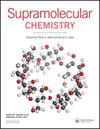柱[5]芳烃与中性二氰丁烷络合现象的量子力学研究
IF 2.6
4区 化学
Q3 CHEMISTRY, MULTIDISCIPLINARY
引用次数: 0
摘要
基于密度泛函理论计算,我们研究了烷基化柱[5]芳烃(P[5]A)和1,4-二氰基丁烷(DCB)为主客体大环之间的电子结构、结合和非共价相互作用的性质。中性1,4-二氰丁烷基烷基化DCB_ProP[5]A与其他三种主-客体大环相比,显示出更高的结合能。这些复合物在很大程度上通过非共价相互作用稳定,这是通过NCI和QTAIM分析确定的。此外,NBO分析的二阶扰动能表明,DCB_ProP[5]A配合物中LP (N) - σ*(C-H)相互作用占主导地位。特别是烷基取代基(-甲基、-乙基和-丙基)在稳定主客体配合物方面起着至关重要的作用。总之,本研究不仅展示了构建烷基化P[5] a包合物新家族的有效策略,而且对宿主环境中与1,4-二氰丁烷(DCB)客体分子的各种非共价相互作用提供了更深入的了解。图形抽象本文章由计算机程序翻译,如有差异,请以英文原文为准。
Quantum mechanical study on complexation phenomenon of pillar[5]arene towards neutral dicyanobutane
ABSTRACT Based on density functional theory calculations, we have addressed the electronic structure, binding and nature of non-covalent interactions between alkylated pillar[5]arene (P[5]A) and 1,4-dicyanobutane (DCB)-based host-guest macrocycles. Neutral 1,4-dicyanobutane-based alkylated DCB_ProP[5]A is found to show higher binding energy when compared to the other three host-guest macrocycles. These complexes are largely stabilised by non-covalent interactions, which are ascertained through NCI and QTAIM analyses. Furthermore, the second-order perturbation energy of NBO analysis show that LP (N) – σ*(C-H) interactions predominate in DCB_ProP[5]A complex. Particularly, alkyl substituents (-methyl, -ethyl and -propyl) are playing a vital role in stabilising the host-guest complexes. In summary, the present work not only exhibits an efficient strategy to build a new family of alkylated P[5]A inclusion complexes but also providing deeper understanding on various non-covalent interactions towards 1,4-dicyanobutane (DCB) guest molecules inside the host environment. Graphical Abstract
求助全文
通过发布文献求助,成功后即可免费获取论文全文。
去求助
来源期刊

Supramolecular Chemistry
化学-化学综合
CiteScore
3.60
自引率
3.00%
发文量
5
审稿时长
2.7 months
期刊介绍:
Supramolecular Chemistry welcomes manuscripts from the fields and sub-disciplines related to supramolecular chemistry and non-covalent interactions. From host-guest chemistry, self-assembly and systems chemistry, through materials chemistry and biochemical systems, we interpret supramolecular chemistry in the broadest possible sense. Interdisciplinary manuscripts are particularly encouraged. Manuscript types include: high priority communications; full papers; reviews, and; Methods papers, techniques tutorials highlighting procedures and technologies that are important to the field. We aim to publish papers in a timely fashion and as soon as a paper has been accepted and typeset it will be published in electronic form on the Latest articles section of the website. The two most important review criteria are that the paper presents high-quality work that fits generally into the broad spectrum of activities in the supramolecular chemistry field. Under normal circumstances, Supramolecular Chemistry does not consider manuscripts that would be more suitable in a highly specialized journal. This includes, but is not limited to, those based mostly or exclusively on topics such as solid state/X-ray structures, computational chemistry, or electrochemistry. .
The two most important review criteria are that the paper presents high-quality work that fits generally into the broad spectrum of activities in the supramolecular chemistry field.
 求助内容:
求助内容: 应助结果提醒方式:
应助结果提醒方式:


